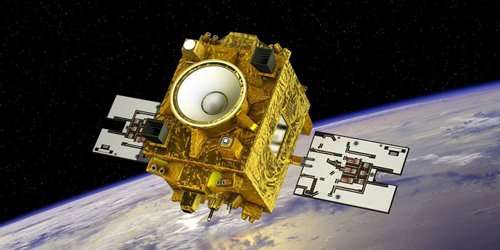December 5, 2017 report
Galileo's free-falling objects experiment passes space test further proving equivalence principle

A team of researchers from the French Aerospace Lab and at the Côte d'Azur Observatory working on France's MICROSCOPE satellite project has further confirmed the equivalence principle by recreating Galileo's free-falling objects experiment in a satellite. In their paper published in the journal Physical Review Letters, the group describes their experiment and why it was carried out.
Approximately 450 years ago, Galileo, as some have reported, dropped cannonballs of different sizes from the Leaning Tower of Pisa to prove that they would hit the ground at the same time. 350 years later, Einstein published his Theory Of General Relativity, which included the equivalence principle, and as Galileo demonstrated, stated that objects with different masses fall at the same rate due to gravity. In this new effort, the researchers have performed roughly the same experiment as Galileo, except they have done it in space and measured the results with far more precision.
Scientists continue to test the equivalence principle because they believe that if they can find a violation, it could reconcile the impasse regarding quantum theory and general relativity.
The experimental equipment aboard the MICROSCOPE satellite consisted of one cylindrical shell set inside of another larger cylindrical shell. The cylinders were small, of course, just a few centimeters long, and were made of different materials—the inner one of platinum and rhodium, the outer from much less dense titanium and aluminum. Running the experiment in space removes factors that can disrupt gravitational force, such as water moving underground. The cylinders free fall as they move through space with an electric field present to keep them from veering from a straight downward path. Their fall is measured very precisely. Any deviations in acceleration would be seen as a change in the electrical field. The team reports that none were found. The researchers report their experiment offered 10 times the precision of previous experiments meant to do the same thing. They note that they believe it will be possible in the future to conduct the same experiment with even more precision by better controlling the temperature inside the satellite.
More information: Pierre Touboul et al. MICROSCOPE Mission: First Results of a Space Test of the Equivalence Principle, Physical Review Letters (2017). DOI: 10.1103/PhysRevLett.119.231101
ABSTRACT
According to the weak equivalence principle, all bodies should fall at the same rate in a gravitational field. The MICROSCOPE satellite, launched in April 2016, aims to test its validity at the 10−15 precision level, by measuring the force required to maintain two test masses (of titanium and platinum alloys) exactly in the same orbit. A nonvanishing result would correspond to a violation of the equivalence principle, or to the discovery of a new long-range force. Analysis of the first data gives
δ(Ti,Pt)=[−1±9(stat)±9(syst)]×10−15 (1σ statistical uncertainty) for the titanium-platinum Eötvös parameter characterizing the relative difference in their free-fall accelerations.
Journal information: Physical Review Letters
© 2017 Phys.org



















